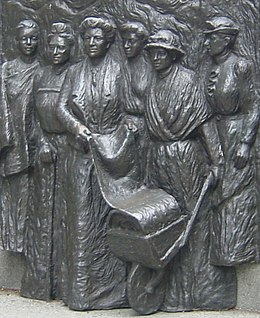
Back حق النساء في التصويت في نيوزيلاندا Arabic নিউজিল্যান্ডে নারীদের ভোটাধিকার Bengali/Bangla Frauenwahlrecht in Neuseeland German Sufragio femenino en Nueva Zelanda Spanish حق رأی زنان در نیوزیلند Persian Droit de vote des femmes en Nouvelle-Zélande French Pravo glasa žena na Novom Zelandu Croatian Hak suara perempuan di Selandia Baru ID Vrouwenkiesrecht in Nieuw-Zeeland Dutch نیوزی لینڈ وچ خواتین دا حق رائے دہی PNB

| Part of a series on |
| Feminism |
|---|
 |
|
|
Women's suffrage was an important political issue in the late-nineteenth-century New Zealand. In early colonial New Zealand, as in European societies, women were excluded from any involvement in politics. Public opinion began to change in the latter half of the nineteenth century and after years of effort by women's suffrage campaigners, led by Kate Sheppard, New Zealand became the first nation in the world in which all women had the right to vote in parliamentary elections.[1]
The Electoral Bill granting women the franchise was given Royal Assent by Governor Lord Glasgow on 19 September 1893. Women voted for the first time in the election held on 28 November 1893 (elections for the Māori electorates were held on 20 December). Also in 1893, Elizabeth Yates became Mayor of Onehunga, the first time such a post had been held by a woman anywhere in the British Empire.[2]
In the 21st century, there are more eligible female voters than male, and women also vote at a higher rate than men.[3] However, a higher percentage of female than male non-voters perceive a barrier that prevents them from voting.[4]
- ^ Cite error: The named reference
NZH1was invoked but never defined (see the help page). - ^ Cite error: The named reference
DNZB Yateswas invoked but never defined (see the help page). - ^ "Voting-age women outnumber men". archive.stats.govt.nz. Retrieved 16 December 2018.
- ^ "Voting and political participation | Stats NZ". www.stats.govt.nz. Retrieved 16 December 2018.